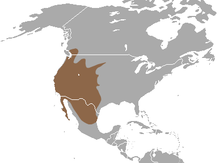Western patchwork skunk
| Western patchwork skunk | ||||||||||||
|---|---|---|---|---|---|---|---|---|---|---|---|---|

Western patchwork skunk |
||||||||||||
| Systematics | ||||||||||||
|
||||||||||||
| Scientific name | ||||||||||||
| Spilogale gracilis | ||||||||||||
| Merriam , 1890 |
The Western Fleckenskunk ( Spilogale gracilis ) is a predator in the genus Fleckenskunks that occurs in western North America.
features
The shape is reminiscent of the Eastern Fleckenskunk ( Spilogale putorius ), but is usually narrower. The fur color is patterned in black and white; there are white spots on the face, white spots and stripes on the trunk, and an almost completely white belly. The black tail is closed off by a white tuft. The claws of the front paws are significantly longer than the claws of the hind paws. With an average head-to-trunk length of 42 cm and a weight of around 570 g, males are larger than females who are around 36 cm long and weigh 370 g. Both have an approximately 13 cm long tail.
distribution and habitat
The distribution area of the western spotted skunk stretches from Canada's southwest corner over large parts of the western USA to central Mexico . The species prefers rocky areas with some bushes. It also occurs in open forests, on the prairie and in cultivated landscapes.
Way of life
Like other skunks, these animals are mostly active at night. In general, each specimen lives alone outside the mating season, but in winter it can happen that females join together in smaller groups that rest in the same burrow. This calm is not a real hibernation . When an individual feels very threatened, like other skunks, they splash a smelly liquid at the attacker.
The diet consists of small mammals , birds and their eggs, insects and scorpions as well as parts of plants such as fruits.
Females are ready to mate from September and choose a partner. The fertilized egg cell only grows to a few cells and then rests for 180 to 200 days. This is followed by the actual gestation of 210 to 230 days, so that the two to five young are born in late spring. On their first outings, the cubs often follow their mother in single file. Females reach sexual maturity after about four to five months.
Systematics
The species was first described by Clinton Hart Merriam in 1890 . The specific epithet gracilis comes from the Latin word for narrow. Initially it was assumed that Spilogale gracilis is only a western population of the Eastern Spotted Skunk, but the delayed embryo development established the species status.
In general, seven subspecies are distinguished:
- S. g. amphiala (= amphialus ) Dickey, 1929 - lives on the Channel Islands of California
- S. g. gracilis Merriam, 1890
- S. g. latifrons Merriam, 1890
- S. g. leucoparia Merriam, 1890
- S. g. lucasana Merriam, 1890
- S. g. martirensis Elliot , 1903
- S. g. phenax Merriam, 1890
| Phylogenetic systematics of the Skunks | ||||||||||||||||||||||||||||||||||||
|---|---|---|---|---|---|---|---|---|---|---|---|---|---|---|---|---|---|---|---|---|---|---|---|---|---|---|---|---|---|---|---|---|---|---|---|---|
|
Within the Spotted Skunk, the phylogenetic position of the Western Spotted Skunk as well as the Dwarf Spotted Skunk has not been conclusively clarified; both could be the sister species of a taxon from the Southern and Eastern Spotted Skunk. The spotted skunks in their entirety represent the sister group of the striped skunks ( Mephitis ). Within the spotted skunks, radiation to the four species known today took place about 3 million years ago, making this genus the youngest within the skunks.
Hazard and protection
The Western Fleckenskunk is classified by the International Union for Conservation of Nature and Natural Resources (IUCN) as not endangered ("least concern") due to its relatively large distribution area and the use of different and also anthropogenically influenced habitats. Although populations are declining in parts of the United States, no threat to the species is anticipated.
The species is primarily endangered by human influences, especially deaths in traffic. In addition, the animals are hunted, with traps and poison bait being used in addition to shooting, and pesticides used against other animals also have an influence on the populations of the skunks. The Western Fleckenskunk is the main supplier of Skunkskins alongside the Eastern Fleckenskunk .
Web links
- Spilogale gracilis in the endangered Red List species the IUCN 2010. Posted by: Cuarón, AD, Reid, F. & slipway, K., 2008. Accessed on December 10 of 2010.
supporting documents
- ↑ a b c d e Spilogale gracilis on Animal Diversity Web, visited December 10, 2010.
- ↑ a b c Spilogale gracilis in the endangered Red List species the IUCN 2010. Posted by: Cuarón, AD, Reid, F. & slipway, K., 2008. Accessed August 24, 2013.
- ^ Spilogale gracilis in the Integrated Taxonomic Information System (ITIS). Retrieved December 8, 2007.
- ↑ Verts, Carraway & Kinlaw. (2001) Mammalian Species: Spilogale gracilis (PDF; 311 kB). American Society of Mammalogists, 674: 1-10.
- ^ Smithsonian : National Museum of Natural History: North American Mammals: Spilogale gracilis ( English ) Retrieved December 8, 2007.
- ^ Wozencraft, W. Christopher (November 16, 2005). "Order Carnivora (pp. 532-628)". In Wilson, Don E., and Reeder, DeeAnn M. (Eds.) Mammal Species of the World : A Taxonomic and Geographic Reference (3rd edition). Baltimore: Johns Hopkins University Press, 2 volumes (2,142 pages). P. 623. ISBN 978-0-8018-8221-0 . on-line
- ↑ a b c Katrin Nyakatura, Olaf RP Bininda-Emonds: Updating the evolutionary history of Carnivora (Mammalia): a new species-level supertree complete with divergence time estimates. BMC Biology 10, 2012. doi: 10.1186 / 1741-7007-10-12
